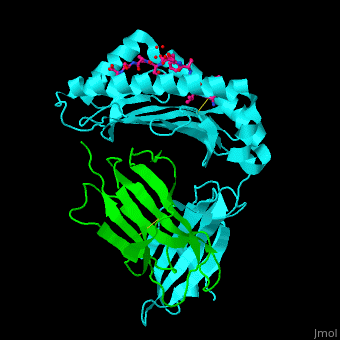Major histocompatibility complex
From Proteopedia
(Difference between revisions)
| Line 11: | Line 11: | ||
== Structural highlights == | == Structural highlights == | ||
| - | Both Class I and Class II MHC molecules are heterodimers with two extracellular subunits (α and β) and one or two transmembrane helices that extend from the extracellular subunits to the cytoplasm. In Class I molecules, the α subunit is divided into three domains (α<sub>1</sub>, α<sub>2</sub>, and α<sub>3</sub>). The α<sub>1</sub> and α<sub>2</sub> domains form an eight strand β-sheet platform and two α-helix rails that | + | Both Class I and Class II MHC molecules are heterodimers with two extracellular subunits (α and β) and one or two transmembrane helices that extend from the extracellular subunits to the cytoplasm. In Class I molecules, the α subunit is divided into three domains (α<sub>1</sub>, α<sub>2</sub>, and α<sub>3</sub>). The α<sub>1</sub> and α<sub>2</sub> domains together form an eight strand β-sheet platform and two α-helix rails that serve as the peptide-binding groove. The α<sub>3</sub> domain forms an immunoglobulin-like fold that carries the peptide-binding groove with added support from with the β subunit (a β<sub>2</sub>-microglobulin molecule encoded outside of the MHC Class I gene locus). In Class II molecules, both the α and β subunits are divided into two domains (α<sub>1</sub>, α<sub>2</sub>,β<sub>1</sub>, and β<sub>2</sub>). The peptide-binding groove is formed by the α<sub>1</sub> and β<sub>1</sub> domains. The α<sub>2</sub> and β<sub>2</sub> domains carry the peptide-binding groove. Unlike the β subunits of Class I molecules, the β subunits of Class II molecules are encoded within the MHC Class II gene. While the α subunit is polymorphic for both MHC Classes, the β subunit is polymorphic only for Class II molecules. |
<scene name='45/457390/Cv/5'>Human MHC class I antigen with β 2-microglobulin and peptide from Hepatitis virus</scene>. | <scene name='45/457390/Cv/5'>Human MHC class I antigen with β 2-microglobulin and peptide from Hepatitis virus</scene>. | ||
The <scene name='45/457390/Cv/6'>peptide derived from Hepatitis virus binds MHC in a peptide-recognition groove and makes various interactions with side chains and with water molecules</scene><ref>PMID:21538979</ref>. Water molecules shown as red spheres. | The <scene name='45/457390/Cv/6'>peptide derived from Hepatitis virus binds MHC in a peptide-recognition groove and makes various interactions with side chains and with water molecules</scene><ref>PMID:21538979</ref>. Water molecules shown as red spheres. | ||
Revision as of 21:20, 21 July 2020
| |||||||||||
References
- ↑ Raghavan M, Del Cid N, Rizvi SM, Peters LR. MHC class I assembly: out and about. Trends Immunol. 2008 Sep;29(9):436-43. doi: 10.1016/j.it.2008.06.004. PMID:18675588 doi:http://dx.doi.org/10.1016/j.it.2008.06.004
- ↑ Holling TM, Schooten E, van Den Elsen PJ. Function and regulation of MHC class II molecules in T-lymphocytes: of mice and men. Hum Immunol. 2004 Apr;65(4):282-90. PMID:15120183 doi:http://dx.doi.org/10.1016/j.humimm.2004.01.005
- ↑ Liu J, Chen KY, Ren EC. Structural insights into the binding of hepatitis B virus core peptide to HLA-A2 alleles: Towards designing better vaccines. Eur J Immunol. 2011 Jul;41(7):2097-106. doi: 10.1002/eji.201041370. PMID:21538979 doi:10.1002/eji.201041370
Proteopedia Page Contributors and Editors (what is this?)
Michal Harel, Joel L. Sussman, Alexander Berchansky, Tihitina Y Aytenfisu, Eric Martz, Sandra B. Gabelli

